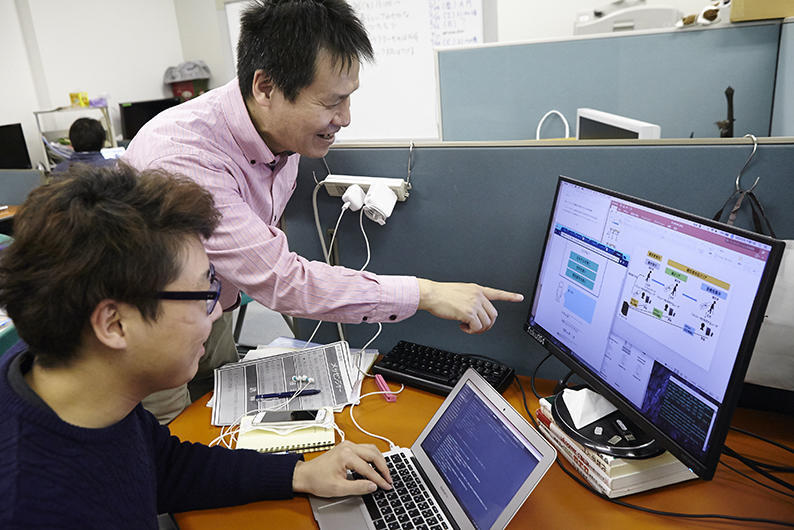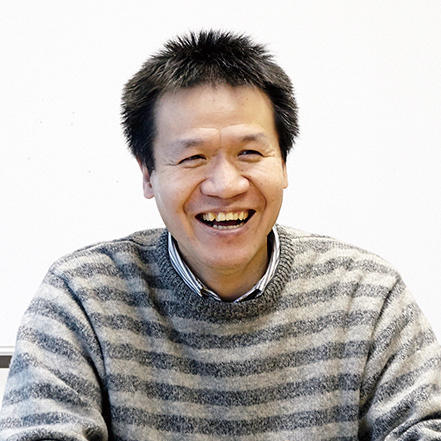- TOP
- Cutting-edge Research and Social Contribution
- Cutting-edge Research
- Building a medical information network in preparation for a huge earthquake, a pioneering effort in Japan!

Building a medical information network in preparation for a huge earthquake, a pioneering effort in Japan!

FUKUMOTO Masahiro
- Specialized field
Signal processing, New generation communication networks
Medical data sharing among Kochi Prefecture's major hospitals, the first such attempt in Japan
The establishment of a disaster-resistant information and telecommunications network is an urgent issue for Japan, which faces high risk of earthquake disaster. During the Great East Japan Earthquake, several hospitals were swept away by the resulting tsunami and enormous amounts of medical data were lost. This proved to be a big obstacle to providing medical treatment for the victims. Since that experience, hospitals across the country are increasingly aware that medical information should be backed up externally. Now Professor Fukumoto is working on building a medical information network for Kochi Prefecture in preparation for the massive Nankai Trough earthquake which is predicted to occur in the near future and would cause enormous damage.
Prof. Fukumoto says, "Examination of the current status of medical data at hospitals in Kochi Prefecture revealed that backups were only available within the source hospitals. If they were swept away, we would have the same situation as in the Great East Japan Earthquake."
Therefore, utilizing JGN, a cutting edge high-speed network for research and development, Prof. Fukumoto collected and unified the medical data of 12 major hospitals in the prefecture and backed them up on a server in eastern Japan. About 70% of the data of Kochi citizens was consolidated there. This was the first effort in the country to establish a mechanism for sharing a prefecture's medical information beyond the walls of hospitals.
Medical data include massive amounts of personal information, so security measures are indispensable. Collecting all data in one place and making a complete backup in one location was possible largely as a result of the utilization of a reliable new generation network with high security and communication capacity. However, that was not sufficient for realization of the system.
Prof. Fukumoto explains, "Generally, sharing medical data with other hospitals has not been considered an option, since the hospitals are in competition with each other. However, the cost would be very high if each hospital made its own external backup. In order to arrive at a shared solution to this problem, the staff in charge of information at each hospital in the prefecture came together for discussions. They achieved a strong collaborative approach which made the system possible. This is the first such effort in the country; there was no precedent."
The strong awareness of the likelihood of disaster and a sense of crisis among hospital personnel in the prefecture gave support to the work of creating a bulk backup of medical data and led to a collaborative connection among hospitals as well.
Since medical data software and even software versions differ from hospital to hospital, the backed up data was not immediately usable. Therefore, in order to enable data access from any hospital, Prof. Fukumoto has been promoting standardization of forms. When that work is completed, the major hospitals in the prefecture will be able to share patients' medical records and their hospital visit histories and medication histories as well. Then the hospitals will be able to avoid unnecessary tests or inappropriate medications, so the system will be useful not only for disaster situations but also for regular health care.
Secret sharing: Developing a mechanism to share only necessary information
To enable medical staff to view electronic medical charts in times of disaster, there are still some problems to be solved. In the event of a disaster, medical staff dispatched from outside will provide medical treatment for injured people and those in distress. Although the outside staff need to view the medical data in order to take appropriate measures for the patients, since personal information is included in the data, third parties may not view them without the patients' agreement.
To overcome that obstacle, Prof. Fukumoto has been working towards a mechanism by which only necessary data can be extracted from the backup data for patient examinations. This method, called "secret sharing system," divides personal information into multiple sets of distributed information and collects some of them when needed to restore the original information. However, the restoration of distributed backed up data using the usual secret sharing system is either all or nothing: the system does not allow for the restoration of just the data needed for medical examination purposes while keeping secret all information not related to the medical work. In response to that problem, Prof. Fukumoto has developed a new method for keeping some parts of distributed data secret when the secret sharing system is accessed.
Prof. Fukumoto explains, "Electronic medical records contain a lot of personal information, but the only information necessary for doctors to decide suitable treatment for the patient is the person's medication history and the name of the person's disease or condition. I have developed a system for selectively restoring only that minimum necessary information."
Thanks to this system, medical staff can easily retrieve, via tablet or personal computer, just the information necessary for appropriate treatment.
"At first glance this new approach seems restricted to medical research, but it can be used in everyday life scenarios as well. I think this system can be applied to the secure storage of personal information in companies and educational institutions. "
Working to extend the medical information network throughout Shikoku
The use of medical data in the event of a disaster requires not only a safe and reliable database but also uninterrupted operation of the network service. That requirement can be met by Software-Defined Network (SDN), developed on JGN. SDN is a new technology that can dynamically set and change network configurations and functions by means of software operations alone. Since SDN makes path switching and flow control possible, essential information can be transferred without fail in times of disaster, times when communication trouble is likely to occur.
"What we are aiming for is a cutting edge medical information system that can be used stably, even in the event of a disaster, a system combining algorithms and new networking technologies. We think that utilizing SDN can enhance performance, and can allow faster realization of the system. By conducting experimental trials, we will continue to enhance the system's reliability and safety," says Prof. Fukumoto.
If a medical information network can be constructed in Kochi Prefecture and the same model can be applied in the other three prefectures of Shikoku, hospitals will be able to share medical data throughout Shikoku.
"In times of disaster, critically ill and injured patients will be transported to neighborhood hospitals regardless of prefectural borders, so we must not have a situation where the electronic medical records of people from one prefecture cannot be accessed in another prefecture. Having data access limited to within a prefecture is not good. Our ultimate goal is to construct a medical network which covers a wide area and allows patients to get appropriate treatment at any hospital in Shikoku."
If this approach could be extended throughout the country, electronic medical records could be viewed at hospitals nationwide. Then people would only have to bring their medical insurance card with them to receive smooth and efficient medical care at any hospital in any region of the country. That kind of system could well be seen in the near future.
Kochi Prefecture is considered a developed prefecture facing challenges related to greying and depopulation. In the information field, there seems to be no apparent merit to a place like Kochi but Prof. Fukumoto points out that, "There are things that only we in Kochi can do because there are not many well established systems here like there are in large cities where IT infrastructure is strongly in place." In addition, he explains, the small population of Kochi Prefecture is perfect for starting new things.
"Kochi Prefecture, with a population of about 750,000 people, is just right for undertaking experimental new things as a prefectural unit. I think that it is easy to take on new challenges from scratch here. That is a lucky research environment for the information field."
